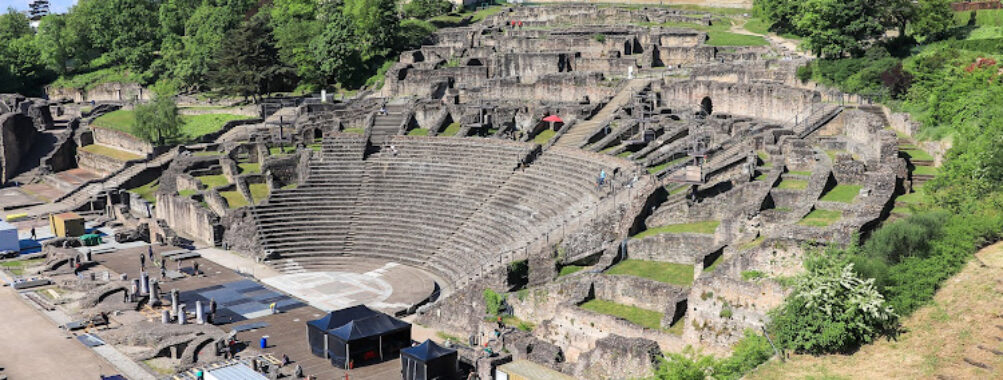
Théâtre Gallo Romain de Lyon-Fourvière
Table of Contents
Location
Places to Stay Near Théâtre Gallo Romain de Lyon-Fourvière"They had things set up for concerts in the evening."
Find and Book a Tour
Explore More Travel Guides
No reviews found! Be the first to review!
Description
Set high above the Rhône and Saône rivers on Lyon’s famous Fourvière hill, the Théâtre Gallo Romain de Lyon-Fourvière offers a vivid window into the ancient world. When you wander through these weathered stone terraces, it’s easy to picture Roman citizens gathering here for drama and socializing nearly two thousand years ago. Built around 15 BCE when Lyon was known as Lugdunum, the site combines two impressive Roman structures: the large theatre and the smaller odeon. Today, these amphitheaters are not just archaeological curiosities—they are woven into Lyon’s cultural life as venues for concerts and festivals as well as being peaceful spots to explore at your own pace.
As you explore the stone seating and ascend the wide semi-circular tiers, the panoramic views over Lyon serve as a dramatic backdrop. What truly stands out is the sense of continuity—you get to sit, wander, and even picnic where ancient Romans did the same centuries before. For anyone passionate about history, architecture, or simply unique outdoor experiences in Lyon, the Roman Theatres are a must-see.
Key Features
- Two Ancient Theatres: The main Roman theater is the oldest in France, able to accommodate up to 10,000 spectators in its heyday. The adjacent odeon, once used for musical performances and readings, seats around 3,000.
- Live Performances: The site is still very much alive—every summer, it hosts the much-loved Nuits de Fourvière festival, drawing international artists for music, drama, and dance performances under the stars.
- Stunning Panoramic Views: From the upper tiers, you get an exceptional view over the red rooftops of Lyon’s Old Town, especially lovely towards sunset.
- Museum of Gallo-Roman Civilisation: Just steps away, this museum houses beautifully preserved mosaics, sculptures, and everyday artifacts unearthed from Fourvière and across Lyon.
- Wheelchair Accessibility: The entrance and parking lot are both wheelchair accessible, making it possible for most visitors to experience the magic of the ancient site.
- Kid-Friendly Exploration: Children tend to love clambering over the ancient stones and imagining the spectacles that once took place here—plus, there’s plenty of open space for them to move around safely.
Best Time to Visit
While the Théâtre Gallo Romain de Lyon-Fourvière can be enjoyed in any season, the experience varies throughout the year. In spring, the surrounding gardens and trees begin to bloom, making the setting especially photogenic. Summer is lively but a bit busier, particularly during the Nuits de Fourvière festival, when the ancient stones echo with music and applause—if you’re interested in live performances, it’s an exciting time to visit. Autumn brings fewer crowds and a golden glow to the landscape, while winter can be quiet and atmospheric, perfect if you’re seeking solitude.
Mornings tend to be more peaceful, with the soft light illuminating the ruins, while late afternoon offers fantastic views as the sun hangs low over the city. If you’re hoping to combine your visit with a festival performance, it’s wise to book tickets well in advance.
How to Get There
Reaching the amphitheaters is easier than it may appear—though perched atop Fourvière hill, several transport options are available. The most popular route is by funicular: from Vieux Lyon – Cathédrale Saint-Jean metro station, take the Funiculaire F2 in the direction of Saint-Just and disembark at Minimes – Théâtre Romains. From there, it’s only a short stroll up to the site itself.
Alternatively, for those who love a scenic workout, you can climb up several staircases and inclines from Lyon’s Old Town; it’s a steep but beautiful ascent through historic neighborhoods and leafy passageways. If you’re arriving by car, there’s a wheelchair accessible parking lot nearby, which is convenient but can fill up quickly during popular events. Public buses also serve the area, though the funicular remains the most atmospheric way to arrive.
Tips for Visiting
- Wear sturdy shoes: The ancient stone steps and terraces are uneven, so comfortable footwear is essential—especially if you plan to explore both the theatre and the odeon.
- Pack snacks and water: There isn’t a restaurant or café directly on-site. If you’re planning a leisurely visit or coming with children, bring refreshments. The upper tiers are a great spot for a simple picnic with a view.
- Don’t miss the museum: Even if ancient ruins aren’t usually your thing, the nearby Museum of Gallo-Roman Civilisation does a fantastic job of bringing Lyon’s Roman heart to life—highly recommended before or after your amphitheater stroll.
- Catch a performance if you can: Experiencing a live concert or play in this extraordinary setting is unforgettable. The sound reverberating between ancient stones is something truly special.
- Check for accessibility: If you require accessible routes, consult the staff or maps at the entrance—while much of the site is accessible, some steep or worn pathways may be trickier to navigate.
- Bring sun protection: The site is mostly open-air, with limited shaded areas, so hats and sunscreen go a long way during sunny weather.
- Combine with other Fourvière sights: The Basilica of Notre-Dame de Fourvière and its breathtaking viewpoint are within easy walking distance, making this area one of the most rewarding to visit in all of Lyon.
- Explore beyond the ruins: Wander the hillside paths and gardens that surround the theatre for glimpses of city vistas and moments of quiet away from the crowds.
Visiting the Théâtre Gallo Romain de Lyon-Fourvière always leaves me with a renewed appreciation for Lyon’s layered history. Whether you’re tracing Roman footsteps, catching a festival show, or simply enjoying the panoramic city views, it’s a place that manages to be both serene and dramatic in equal measure. If ancient ruins, live arts, and city skylines appeal to you, this remarkable corner of Lyon is not to be missed.